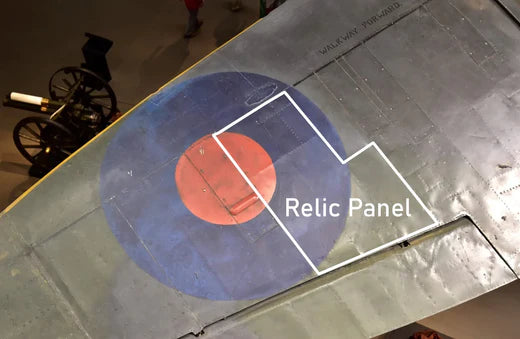This Fine Art Print by Artist Craig Tinder illustrates Flt. Lt. Eric Stanley Lock of No. 611 Squadron - the highest-scoring Allied pilot during the Battle of Britain.
Details About the RELIC:
This aluminum relic is from Supermarine Spitfire Mk.Vb, AD391, flown by 313 Squadron. On February 23, 1942, the aircraft tragically crashed into the sea near the Royal Artillery Experimental Station in Shoeburyness, Essex. Eyewitnesses reported that the starboard wing touched the water, causing the aircraft to bounce twice before plunging into the sea. The wreckage remained submerged until it was recovered in the early 1980s.
 Panel from Spitfire AD391 used as relic in "Cannon Hit" limited edition print
Panel from Spitfire AD391 used as relic in "Cannon Hit" limited edition print
 Outline of the above panel to denote location. Notice how the paint colors deteriorated from the saltwater, except for the red color
Outline of the above panel to denote location. Notice how the paint colors deteriorated from the saltwater, except for the red color
The authentic aluminum panel originates from the port wing, positioned between ribs 14 and 17. The large panel retains its original rivets and the paint from the national roundel markings, offering a glimpse into its wartime service. This relic, along with other Spitfire parts, was used in the restoration of Spitfire Mark LF/IX TE517, serving as a template for creating new wing panels to ensure the restoration’s authenticity.
 Artist, Craig Tinder, posing with "Cannon Hit" limited edition print that includes a Spitfire relic
Artist, Craig Tinder, posing with "Cannon Hit" limited edition print that includes a Spitfire relic
Recovered by The Southend Historic Aircraft Museum during the 1970s, the remains of the Spitfire were accessible during exceptionally low tides. The museum's collection included this panel along with the aircraft’s canopy, tail wheel, and various instruments. Today, these parts offer a tangible link to the history of the Spitfire and its service during World War II, preserving the legacy of one of the most iconic aircraft of the era.
The Story Behind the Print:
On July 14, 1941, Flt. Lt. Eric Stanley Lock, flying with No. 611 Squadron, engaged a Messerschmitt Bf 109 over northern France. In his Spitfire Mk VB, Lock skillfully maneuvered into position, unleashing a precise burst of gunfire that struck the enemy fighter. The Bf 109 plummeted from the sky, marking Lock’s 26th confirmed aerial victory. This feat cemented his status as one of the most accomplished RAF pilots of the war, renowned for his precision and tenacity.
Lock had already achieved legendary status during the Battle of Britain, where he was credited with 21 victories, making him the highest-scoring Allied ace of that crucial campaign. His quick reflexes and fearless pursuit of enemy aircraft earned him the nickname "Sawn Off Lockie" due to his relatively small stature. His success was not only a testament to his exceptional flying skills but also to the resilience and determination of the RAF during a pivotal moment in the war.
Despite his remarkable achievements, Lock’s wartime career ended in tragedy. On August 3, 1941, during a ground-strafing mission in northern France, he took off in Spitfire W3257 and was never seen again. His disappearance remains a mystery, and his body was never recovered. Today, Lock is remembered as one of the RAF’s finest, a symbol of courage and sacrifice during Britain's darkest hour.
Learn more about the An In-Depth Comparison of Two Aviation Titans of the Spitfire vs. Hurricane. Click Here
To purchase or see similar items, visit here.
Commissioned by Museums, Treasured by Collectors





Share:
Homeward Bound with Shady Lady
Defenders of Britain, the story behind "Homeland Formation"